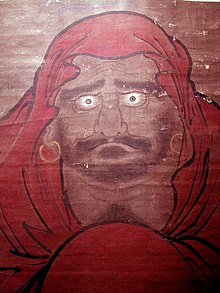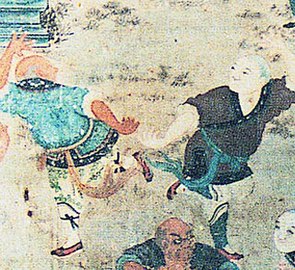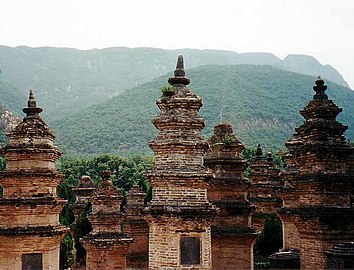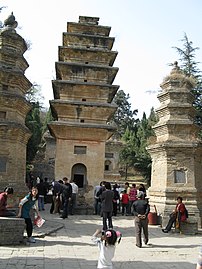| Shaolin Monastery | |
|---|---|
少林寺
| |

Shaolin Monastery
| |
| Religion | |
| Affiliation | Buddhism |
| Year consecrated | 5th century CE |
| Status | Active |
| Location | |
| Location | Dengfeng, Zhengzhou, Henan |
| Country | |
| Geographic coordinates | 34°30′27″N 112°56′07″ECoordinates: 34°30′27″N 112°56′07″E |
| Website | |
| www | |
| Shaolin Monastery | |
|---|---|

"Shaolin Temple" in Chinese characters
| |
| Chinese | 少林寺 |
| Literal meaning | "Temple of Shao[shi Mountain] Woods" |
The Shaolin Monastery (Chinese: 少林寺; pinyin: Shàolín sì), also known as the Shaolin Temple, is a Chan ("Zen") Buddhist temple in Dengfeng County, Henan Province, China.
Believed to have been founded in the fifth century, the Shaolin Temple
is the main temple of the Shaolin school of Buddhism to this day.
Located 90 kilometres (56 miles) west of the city of Zhengzhou, the Shaolin Monastery and its Pagoda Forest were inscribed as a UNESCO World Heritage Site in 2010 as part of the "Historic Monuments of Dengfeng".
History
Establishment
The name refers to the woods of Shaoshi (少室; Shǎo Shì) mountain, one of the seven peaks of the Song mountains. The first Shaolin Monastery abbot was Batuo (also called Fotuo or Buddhabhadra), a dhyāna master who came to ancient China from ancient India or from Central Asia in 464 AD to spread Buddhist teachings.
According to the Continued Biographies of Eminent Monks (645 AD) by Daoxuan, Shaolin Monastery was built on the north side of Shaoshi, the central peak of Mount Song, one of the Sacred Mountains of China, by Emperor Xiaowen of the Northern Wei dynasty in 477 AD, to accommodate the Indian master beside the capital Luoyang city. Yang Xuanzhi, in the Record of the Buddhist Monasteries of Luoyang (547 AD), and Li Xian, in the Ming Yitongzhi (1461), concur with Daoxuan's location and attribution. The Jiaqing Chongxiu Yitongzhi (1843) specifies that this monastery, located in the province of Henan, was built in the 20th year of the Taihe era of the Northern Wei dynasty, that is, the monastery was built in 495 AD.
As the center of Chan Buddhism, the Shaolin Temple attracted many emperors’ attention in China’s history. During the Tang dynasty 618–907 AD Empress Wu Zetian
(AD 625–705) paid several visits to the Shaolin Temple discussing Chan
philosophy with high monk Tan Zong. According to legend, Emperor Taizong granted the Shaolin Temple extra land and a special "imperial dispensation" to consume meat and alcohol during the Tang dynasty.
If true, this would have made Shaolin the only temple in China that did
not prohibit alcohol. Regardless of historical veracity, these rituals
are not practiced today.
This legend is not corroborated in any period documents, such as the
Shaolin Stele erected in 728. The stele does not list any such imperial
dispensation as reward for the monks' assistance during the campaign
against Wang Shichong, only land and a water mill are granted.[5] The founder of the Yuan dynasty, Kublai Khan (AD 1215–1294) ordered all Buddhist temples in China to be led by the Shaolin Temple; eight princes during the Ming dynasty turned themselves into Shaolin monks.
Picture of Bodhidharma at Himeji Castle.
Traditionally Bodhidharma
is credited as founder of the martial arts at the Shaolin Temple.
However, martial arts historians have shown this legend stems from a
17th-century qigong manual known as the Yijin Jing.
The authenticity of the Yi Jin Jing has been discredited by some historians including Tang Hao, Xu Zhen and Ryuchi Matsuda. This argument is summarized by modern historian Lin Boyuan in his Zhongguo wushu shi:
As for the "Yi Jin Jing" (Muscle Change Classic), a spurious text attributed to Bodhidharma and included in the legend of his transmitting martial arts at the temple, it was written in the Ming dynasty, in 1624, by the Daoist priest Zining of Mt. Tiantai, and falsely attributed to Bodhidharma. Forged prefaces, attributed to the Tang general Li Jing and the Southern Song general Niu Gao were written. They say that, after Bodhidharma faced the wall for nine years at Shaolin temple, he left behind an iron chest; when the monks opened this chest they found the two books "Xi Sui Jing" (Marrow Washing Classic) and "Yi Jin Jing" within. The first book was taken by his disciple Huike, and disappeared; as for the second, "the monks selfishly coveted it, practicing the skills therein, falling into heterodox ways, and losing the correct purpose of cultivating the Real. The Shaolin monks have made some fame for themselves through their fighting skill; this is all due to having obtained this manuscript". Based on this, Bodhidharma was claimed to be the ancestor of Shaolin martial arts. This manuscript is full of errors, absurdities and fantastic claims; it cannot be taken as a legitimate source.
The oldest available copy was published in 1827. The composition of the text itself has been dated to 1624.
Even then, the association of Bodhidharma with martial arts only became
widespread as a result of the 1904–1907 serialization of the novel The Travels of Lao Ts'an in Illustrated Fiction Magazine:
One of the most recently invented and familiar of the Shaolin historical narratives is a story that claims that the Indian monk Bodhidharma, the supposed founder of Chinese Chan (Zen) Buddhism, introduced boxing into the monastery as a form of exercise around a.d. 525. This story first appeared in a popular novel, The Travels of Lao T’san, published as a series in a literary magazine in 1907. This story was quickly picked up by others and spread rapidly through publication in a popular contemporary boxing manual, Secrets of Shaolin Boxing Methods, and the first Chinese physical culture history published in 1919. As a result, it has enjoyed vast oral circulation and is one of the most “sacred” of the narratives shared within Chinese and Chinese-derived martial arts. That this story is clearly a twentieth-century invention is confirmed by writings going back at least 250 years earlier, which mention both Bodhidharma and martial arts but make no connection between the two.
Other scholars see an earlier connection between Da Mo and the
Shaolin Monastery. Scholars generally accept the historicity of Da Mo
(Bodhidharma) who arrived in China from his country India
around 480. Da Mo (Bodhidharma) and his disciples are said to have
lived a spot about a mile from the Shaolin Temple that is now a small
nunnery.
In the 6th century, around 547, The Record of the Buddhist Monasteries says Da Mo visited the area near Mount Song. In 645 The Continuation of the Biographies of Eminent Monks describes him as being active in the Mount Song region.
Around 710 Da Mo is identified specifically with the Shaolin Temple
(Precious Record of Dharma's Transmission or Chuanfa Baoji) and writes of his sitting facing a wall in meditation for many years.
It also speaks of Huikes many trials in his efforts to receive
instruction from Da Mo. In the 11th century a (1004) work embellishes
Da Mo legends with great detail. A stele inscription at the Shaolin
Monastery dated 728 reveals Da Mo residing on Mount Song.
Another stele in 798 speaks of Huike seeking instruction from Da Mo.
Another engraving dated 1209 depicts the barefoot saint holding a shoe
according to the ancient legend of Da Mo. A plethora of 13th- and
14th-century steles feature Da Mo in Various roles. One 13th-century
image shows him riding a fragile stalk across the Yangtze River. In 1125 a special temple was constructed in his honor at the Shaolin Monastery.
Destructions and renovations
The monastery has been destroyed and rebuilt many times. During the Red Turban Rebellion
in the 14th century, bandits ransacked the monastery for its real or
supposed valuables, destroying much of the temple and driving the monks
away. The monastery was likely abandoned from 1351 or 1356 (the most
likely dates for the attack) to at least 1359, when government troops
retook Henan. The events of this period would later figure heavily in
16th-century legends of the temple's patron saint Vajrapani, with the story being changed to claim a victory for the monks, rather than a defeat.
In 1641, rebel forces led by Li Zicheng sacked the monastery due to the monks' support of the Ming dynasty and the possible threat they posed to the rebels. This effectively destroyed the temple's fighting force. The temple fell into ruin and was home to only a few monks until the early 18th century, when the government of the Qing dynasty patronized and restored the temple.
Perhaps the best-known story of the Temple's destruction is that
it was destroyed by the Qing government for supposed anti-Qing
activities. Variously said to have taken place in 1647 under the Shunzhi Emperor, in 1674, 1677, or 1714 under the Kangxi Emperor, or in 1728 or 1732 under the Yongzheng Emperor, this destruction is also supposed to have helped spread Shaolin martial arts through China by means of the five fugitive monks.
Some accounts claim that a supposed southern Shaolin Temple was
destroyed instead of, or in addition to, the temple in Henan: Ju Ke, in
the Qing bai lei chao (1917), locates this temple in Fujian province. These stories commonly appear in legendary or popular accounts of martial history, and in wuxia fiction.
While these latter accounts are popular among martial artists,
and often serve as origin stories for various martial arts styles, they
are viewed by scholars as fictional. The accounts are known through
often inconsistent 19th-century secret society histories and popular
literature, and also appear to draw on both Fujianese folklore and
popular narratives such as the classical novel Water Margin. Modern scholarly attention to the tales is mainly concerned with their role as folklore.
Recent history
There is evidence of Shaolin martial arts being exported to Japan since the 18th century. Martial arts such as Okinawan Shōrin-ryū (小林流) style of Karate, for example, has a name meaning "Shaolin School" and the Japanese Shorinji Kempo
(少林寺拳法) is translated as "Shaolin Temple Fist Method". Other
similarities can be seen in centuries-old Chinese and Japanese martial
arts manuals.
In 1928, the warlord Shi Yousan
set fire to the monastery, burning it for over 40 days, destroying a
significant percent of the buildings, including many manuscripts of the
temple library.
The Cultural Revolution launched in 1966 targeted religious orders including the monastery. The five monks who were present at the monastery when the Red Guards attacked were shackled and made to wear placards declaring the crimes charged against them. The monks were jailed after publicly being flogged and paraded through the street as people threw rubbish at them. The government purged Buddhist materials from within the monastery walls, leaving it barren for years.
The film crew for the Jet Li movie Martial Arts of Shaolin was shocked to find that there were no remaining monks when they filmed at the monastery complex in 1986.
Martial arts groups from all over the world have made donations
for the upkeep of the temple and grounds, and are subsequently honored
with carved stones near the entrance of the temple. In the past, many
have tried to capitalise on Shaolin Monastery fame by building their own
schools on Mount Song. However, the Chinese government eventually
outlawed this; the schools were moved to the nearby towns.
A dharma gathering was held from 19 August to 20 August 1999, in Shaolin Monastery for Shi Yongxin's assumption of office as abbot. Over the next two decades the Monastery grew into a global business empire. In March 2006, Russian President Vladimir Putin
became the first foreign leader to visit the monastery. In 2007, the
Chinese government partially lifted the 300-year ban of the Jieba, the
ancient ceremony of the nine marks which are burned onto the head with
sticks of incense. The ban was lifted only for those who were mentally
and physically prepared to participate in the tradition.
Two modern bathrooms were recently added to the temple for use by
monks and tourists. The new bathrooms reportedly cost three million yuan to build. Films have also been released like Shaolin Temple and more recently, Shaolin starring Andy Lau.
In 1994 the temple registered its name as a trademark. In the
late 2000s, Shi Yongxin began authorizing Shaolin branches outside of
mainland China in what has been called a franchise scheme. The branches
are run by current and former monks and allow dispersion of Shaolin
culture and study of Shaolin kung fu around the world.
As of January, 2011, Yongxin and the temple operated over 40 companies
in cities across the world, including London and Berlin, which have
purchased land and property.
In 2018, for the first time in its 1500-year history, the Shaolin Monastery raised the national flag as a part of a "patriotism drive" under the new National Religious Affairs Administration, a part of the United Front Work Department which "oversees propaganda efforts as well as relations with the global Chinese diaspora". Senior theology lecturer Sze Chi Chan of Hong Kong Baptist University analyzes this move as General Secretary Xi Jinping making an example of the Shaolin Monastery to send a message to other temples and the Chinese Catholic Church.
Governance
The
Shaolin Monastery was historically led by an abbot, but the communist
era restrictions on religious expression and independence have since
changed this ancient system. The monastery is currently led by a
committee composed primarily of government officials. The treasurer is
appointed by the government, and as such the abbot has little control
over finances. Profits are split with Dengfeng; the municipality takes two thirds of the profits and the monastery retains one third.
Shaolin temple buildings
The temple's inside area is 160 by 360 meters (520 ft × 1,180 ft),
that is, 57,600 square meters (620,000 sq ft). It has seven main halls
on the axis and seven other halls around, with several yards around the
halls. The temple structure includes:
- Mountain Gate (山门; shan men) (built 1735; The entrance tablet written with golden characters "Shaolin Temple" (少林寺; shao lin si) in black background by the Kangxi Emperor of the Qing dynasty in 1704).
- Forest of Steles (碑林; bei lin)
- Ciyun Hall (慈雲堂; ci yun tang) (built 1686; changed 1735; reconstructed 1984). It includes Corridor of Steles (碑廊; bei lang), which has 124 stone tablets of various dynasties since the Northern Qi dynasty (550–570).
- West Arrival Hall (西来堂; xi lai tang) a.k.a. Kung fu Hall (锤谱堂; chui pu tang) (built 1984).
- Heavenly Kings (Devaraja) Palace Hall (天王殿; tian wang dian) (built in Yuan dynasty; repaired in Ming, Qing dynasties).
- Bell Tower (钟楼; zhong lou) (built 1345; reconstructed 1994; the bell was built in 1204).
- Drum Tower (鼓楼; gu lou) (built 1300; reconstructed 1996).
- Kimnara Palace Hall (紧那罗殿; jin na luo dian) (reconstructed 1982).
- Six Patriarchs Hall (六祖堂; liu zu tang)
- Mahavira Palace Hall (大雄宝殿; da xiong bao dian) a.k.a. Main Hall or Great Hall (built maybe 1169; reconstructed 1985).
- Dining Hall: (built in Tang dynasty; reconstructed 1995).
- Sutra Room
- Dhyana Halls: (reconstructed 1981).
- Guest Reception Hall
- Dharma (Sermon) Hall (法堂; fa tang) a.k.a. Scripture Room (藏经阁; zang jing ge): (reconstructed 1993).
- East & West Guests Rooms
- Abbot's Room (方丈室; fang zhang shi) (built in early Ming dynasty).
- Standing in Snow Pavilion (立雪亭; li xue ting) a.k.a. Bodhidharma Bower (达摩庭; da mo ting): (reconstructed 1983).
- Manjusri Palace Hall (wen shu dian) (reconstructed 1983).
- Samantabhadra Palace Hall
- White Robe (Avalokitesvara) Palace Hall (白衣殿; bai yi (Guan yin) dian) a.k.a. Kung fu Hall (quan pu dian) (built in Qing dynasty).
- Ksitigarbha Palace Hall (地臧殿; di zang dian): (built in early Qing dynasty; reconstructed 1979).
- 1000 Buddha Palace Hall (千佛殿; qian fo dian) a.k.a. Vairocana Pavilion (毗庐阁; pi lu ge): (built 1588; repaired 1639,1776).
- Ordination Platform (built 2006).
- Monks' Rooms
- Shaolin Pharmacy Bureau (built 1217; reconstructed 2004).
- Bodhidharma Pavilion (chu zu an) (built first in Song dynasty)
- Bodhidharma Cave
- Forest of Pagodas Yard (塔林院; ta lin yuan): (built before 791). It has 240 tomb pagodas of various sizes from the Tang, Song, Jin, Yuan, Ming, and Qing dynasties (618–1911).
- Shaolin Temple Wushu Guan (Martial arts hall)
Southern and Northern Shaolin Monasteries
A number of traditions make reference to a Southern Shaolin Monastery located in Fujian province.
There has also been a Northern Shaolin monastery in northern China.
Associated with stories of the supposed burning of Shaolin by the Qing government and with the tales of the Five Elders,
this temple, sometimes known by the name Changlin, is often claimed to
have been either the target of Qing forces or a place of refuge for
monks displaced by attacks on the Shaolin Monastery in Henan. Besides
the debate over the historicity of the Qing-era destruction, it is
currently unknown whether there was a true southern temple, with several
locations in Fujian given as the location for the monastery. Fujian
does have a historic monastery called Changlin, and a monastery referred
to as a "Shaolin cloister" has existed in Fuqing, Fujian, since the Song dynasty, but whether these have an actual connection to the Henan monastery or a martial tradition is still unknown. The Southern Temple has been a popular subject of wuxia fiction, first appearing in the 1893 novel Shengchao Ding Sheng Wannian Qing, where it is attacked by the Qianlong Emperor with the help of the White Eyebrow Taoist.








